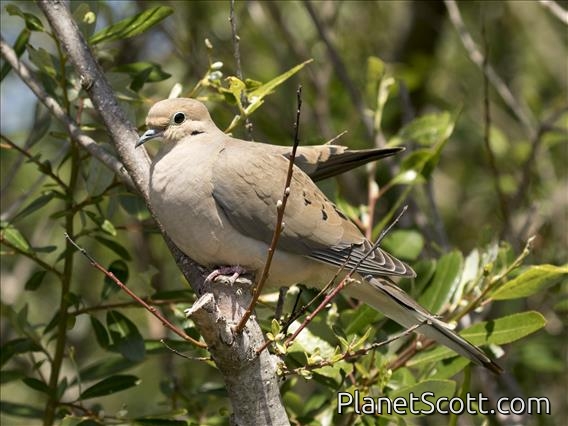Mourning Dove (Zenaida macroura)






About Mourning Dove (Zenaida macroura)
- Kingdom: Animals
- Phylum: Chordates
- Class: Birds
- Order: Doves and Pigeons
- Family: Pigeons and Doves
The mourning dove is a member of the dove family, Columbidae. The bird is also known as the American mourning dove, the rain dove, the chueybird, colloquially as the turtle dove, and it was once known as the Carolina pigeon and Carolina turtledove. It is one of the most abundant and widespread North American birds and a popular gamebird, with more than 20 million birds shot annually in the U.S., both for sport and meat. Its ability to sustain its population under such pressure is due to its prolific breeding; in warm areas, one pair may raise up to six broods of two young each in a single year. The wings make an unusual whistling sound upon take-off and landing, a form of sonation. The bird is a strong flier, capable of speeds up to 88 km/h (55 mph).
Source: Wikipedia
Lifelists
Trips
Visits
-
1983-06-06
Elgin, United States of America -
1995-06-15
Mission - My Backyard, United States of America -
2006-05-16
Bernal Hill, United States of America -
2006-08-15
Canyonlands National Park, United States of America -
2007-01-01
Candlestick Park, United States of America -
2007-04-09
Anza-Borrego Desert State Park, United States of America -
2007-06-14
Cape May National Wildlife Refuge - Deleware Bay, United States of AmericaNear this location. -
2007-07-28
Presidio - El Polin Spring, United States of America -
2008-01-17
Mission Creek, United States of America -
2008-08-24
Giants Park, United States of America -
2008-09-17
Potrero Recreation Center, United States of America -
2009-04-04
Bernal Hill, United States of America -
2009-05-05
Elgin - Bluff Spring Fen, United States of America -
2009-11-22
Palo Alto Baylands, United States of America -
2010-02-20
Temescaltepec, Mexico -
2010-10-30
Miller Meadow Forest Preserve, United States of America -
2010-11-20
Elgin - Bluff Spring Fen, United States of America -
2011-05-29
Del Puerto Canyon and Mines Road, United States of America -
2011-07-10
Santa Fe River, United States of America -
2011-10-08
Crabtree Nature Center, United States of America -
2012-05-20
Pyramid Lake, United States of America -
-
2012-06-13
Mount Davidson, United States of America -
2012-06-25
Bernal Hill, United States of America -
2012-07-08
Elgin, United States of America -
2012-07-08
Necedah NWR, United States of America -
2012-07-09
Sax-Zim Bog, United States of America -
2012-07-10
170th St , United States of America -
2012-07-10
Bluestem Prairie, United States of America -
2012-07-11
Theodore Roosevelt National Park - South Unit, United States of America -
2012-07-13
Grand Teton National Park, United States of America -
2012-08-12
Foster City Beach, United States of America -
2012-09-22
East Wash, United States of America -
2012-11-03
Honolulu Int'l AP, United States of America -
2013-03-04
John Heinz NWR at Tinicum (IBA), United States of America -
2013-03-07
Spring Valley Nature Sanctuary, United States of America -
2013-04-14
Austin, United States of America -
2013-04-17
Brazoria NWR (UTC 108), United States of America -
2013-04-19
Bolivar Peninsula, United States of America -
2013-04-20
Attwater Prairie Chicken National Wildlife Refuge, United States of America -
2013-05-12
Redwood Valley, United States of America -
2013-06-05
Lake Tabeaud, United States of America -
2013-07-06
Castle Rock Park (CC Co.), United States of America -
2013-08-25
Ventana Wilderness, United States of America -
2013-09-07
Mountain Lake, United States of America -
2013-09-08
Bernal Hill, United States of America -
2013-09-28
Presidio - El Polin Spring, United States of America -
2013-10-06
Bernal Hill, United States of America -
2014-01-04
Golden Gate Park - San Francisco Botanical Garden, United States of America -
2014-01-20
Zapoten, Dominican Republic -
-
2014-01-22
El Aceitillar, Dominican Republic -
2014-01-23
Cachote, Dominican Republic -
2014-01-27
Santo Domingo - Botanical Gardens, Dominican Republic -
2014-02-20
Mission - My New Backyard, United States of America -
2014-02-22
Panoche Valley, United States of America -
2014-03-08
Tule Elk State Reserve, United States of America -
2014-03-09
Los Angeles County Arboretum and Botanic Garden, United States of America -
2014-03-15
Alemany Community Garden, United States of America -
2014-04-05
Cosumnes River Preserve, United States of America -
2014-04-06
Delta Meadows State Park, United States of America -
2014-05-03
Glen Canyon Park, United States of America -
2014-05-09
Cave Creek Canyon--Southwestern Research Station, United States of America -
2014-05-09
Portal--Big Thicket, United States of America -
2014-05-10
Pinery Canyon Rd. (grasslands section only), United States of America -
2014-05-11
San Pedro RNCA--San Pedro House, United States of America -
2014-06-07
Sunol Regional Wilderness--Visitor Center area, United States of America -
2014-06-14
Peaarson-Arastradero Preserve, United States of America -
2014-06-15
Golden Gate Park - North Lake, United States of America -
2014-06-22
Redwood Valley, United States of America -
2014-09-14
Buena Vista Park, United States of America -
2014-09-23
Redwood Valley, United States of America -
2015-01-02
Pixley NWR, United States of America -
2015-01-03
Woodward Park, United States of America -
2015-01-04
Panoche Valley, United States of America -
2015-01-19
Lake Merced , United States of America -
-
2015-03-13
Holbrook Palmer Park, United States of America -
-
-
-
-
-
-
-
-
-
-
-
-
-
-
-
-
-
-
-
-
-
-
-
-
-
-
-
-
-
-
-
-
-
-
-
-
-
-
-
-
-
-
-
-
-
-
-
2021-06-10
Bishop, United States of America -
-
-
-
-
-
-
-
-
-
-
-
-
-
-
-
-
-
-
-
-
-
-
-
-
-
-
-
-
-
-
-
-
-
-
-
-
-
-
-
-







